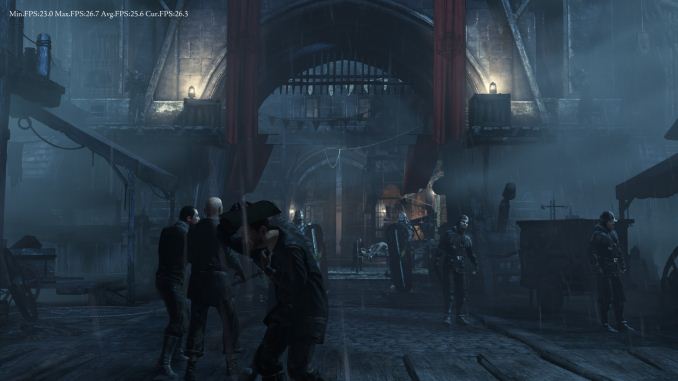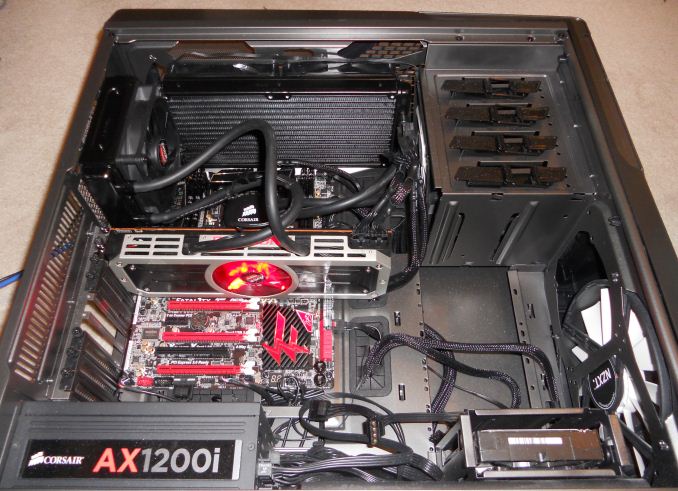The AMD Radeon R9 295X2 Review
by Ryan Smith on April 8, 2014 8:00 AM EST- Posted in
- GPUs
- AMD
- Radeon
- Radeon 200
The Test
Starting with today’s article we’ve made a small change to our suite of games. We are replacing our last 2012 game, Hitman: Absolution with another Square Enix title: the recently released Thief. Both games make use of many of the same graphical features, and both games include a built-in benchmark that is a good approximation of what a worst case rendering load in the game will behave like, making Thief a solid replacement for the older Hitman.
Meanwhile we’ve also updated all of our benchmark results to reflect the latest drivers from AMD and NVIDIA. For all AMD cards we are using AMD’s R9 295X2 launch drivers, Catalyst 14.4. Catalyst 14.4 appears to be a new branch of AMD’s drivers, given the version number 14.100, however we have found very few performance changes in our tests.
As for NVIDIA cards, we’re using the just-launched 337.50 drivers. These drivers contain a collection of performance improvements for NVIDIA cards and coincidentally come at just the right time for NVIDIA to counter AMD’s latest product launch.
We also need to quickly note that because AMD’s Radeon R9 295X2 uses an external 120mm radiator, we’ve had to modify our testbed to house the card. For our R9 295X2 tests we have pulled our testbed’s rear 140mm fan and replaced it with the R9 295X2 radiator. All other tests have the 140mm fan installed as normal.
| CPU: | Intel Core i7-4960X @ 4.2GHz |
| Motherboard: | ASRock Fatal1ty X79 Professional |
| Power Supply: | Corsair AX1200i |
| Hard Disk: | Samsung SSD 840 EVO (750GB) |
| Memory: | G.Skill RipjawZ DDR3-1866 4 x 8GB (9-10-9-26) |
| Case: | NZXT Phantom 630 Windowed Edition |
| Monitor: | Asus PQ321 |
| Video Cards: |
AMD Radeon R9 295X2 AMD Radeon R9 290X AMD Radeon R9 290 AMD Radeon HD 7990 AMD Radeon HD 6990 NVIDIA GeForce GTX Titan Black NVIDIA GeForce GTX 780 Ti NVIDIA GeForce GTX 780 NVIDIA GeForce GTX 690 NVIDIA GeForce GTX 590 |
| Video Drivers: |
NVIDIA Release 337.50 Beta AMD Catalyst 14.4 Beta |
| OS: | Windows 8.1 Pro |












131 Comments
View All Comments
Dustin Sklavos - Tuesday, April 8, 2014 - link
Single cable is beyond spec for the connector. We've been hearing connectors actually melting. "Crappy" isn't really relevant here; this is the *only* card on the market that causes these kinds of problems.Anders CT - Tuesday, April 8, 2014 - link
500 watt power consumption is insane. It should come with an on-board dieselgenerator.Blitzninjasensei - Saturday, July 12, 2014 - link
The thought of this made my day. Thanks for the joke, needed it.therfman - Tuesday, April 8, 2014 - link
This is all very nice, but unless case space is at a premium, I fail to see the advantage of this card over two 290X cards with good coolers. The PowerColor PCS+ version of the 290X runs at 1050 MHz, is much quieter than the reference boards (40-42 dBA under load at 75cm), and is available for under $600. Is having a single-slot solution worth $300 extra? Not unless you really want have everything in a small form factor case.Peeping Tom - Tuesday, April 8, 2014 - link
Is that a giveaway I hear coming? ;-)silverblue - Tuesday, April 8, 2014 - link
Please, don't... I don't think I could stand to see a card of this calibre being offered only to those in the States... :|JBVertexx - Tuesday, April 8, 2014 - link
Is there any way to tell the temperatures of each of the two GPUs? Where does the temperature reading for the testing come from - is it an average of the 2, the hotter, or the cooler one?Reason I'm asking is I was skeptical a 120mm rad could effectively cool two of these GPUs. Given they are connected in series, one is bound to be measurably hotter than the other.
Otherwise, this looks to be a winner. I was considering upgrading my uATX rig so I could do SLI. But with this card, I could keep the compact form factor.
JBVertexx - Tuesday, April 8, 2014 - link
After some additional research on the web, it looks like the difference in temps between the 2 GPUs is only about 2 degrees under load, so pleasantly surprised with how well the 120mm radiator handles the cooling.Ryan Smith - Tuesday, April 8, 2014 - link
The temperature readings come from MSI Afterburner, which is capable of reading the temperatures via AMD's driver API. And unless otherwise noted, the temperature is always the hottest temperature.srsbsns - Tuesday, April 8, 2014 - link
The point of this driver was improvements the the HD7000 series and their rebrands... Anandtech missed this by benching an already optimized 290x dual card?